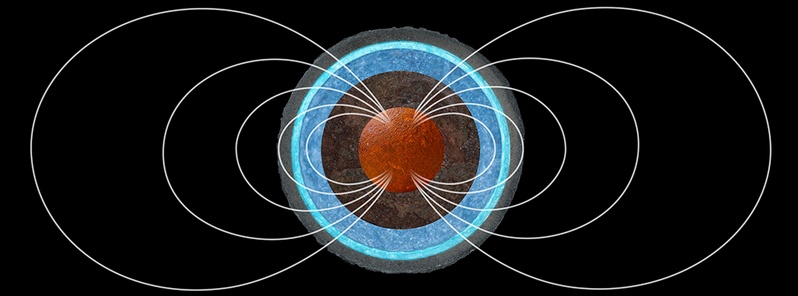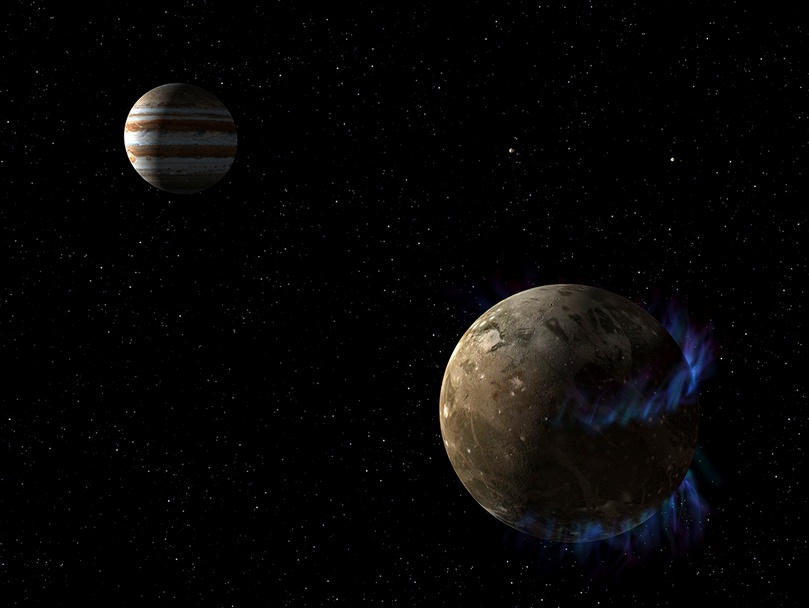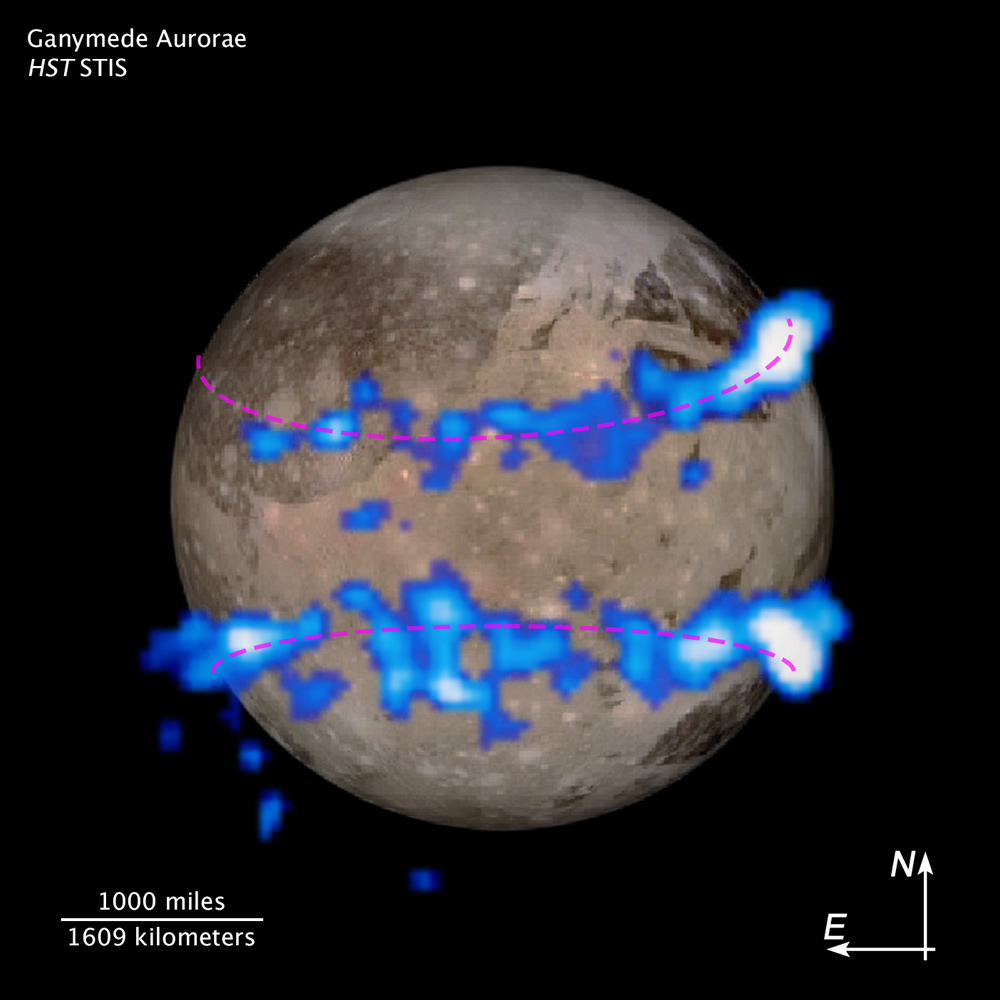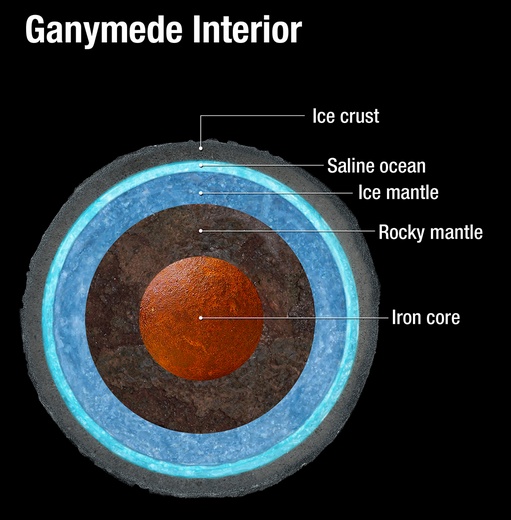Large underground ocean on Ganymede, Jupiter’s largest moon

Hubble Space Telescope has the best evidence yet for an underground saltwater ocean on Ganymede, Jupiter’s largest moon. The subterranean ocean is thought to have more water than all the water on Earth's surface. Identifying liquid water is crucial in the search for habitable worlds beyond Earth and for the search of life as we know it.
Ganymede is the largest moon in our solar system and the only moon with its own magnetic field. The magnetic field causes aurorae, which are ribbons of glowing, hot electrified gas, in regions circling the north and south poles of the moon. Because Ganymede is close to Jupiter, it is also embedded in Jupiter’s magnetic field. When Jupiter’s magnetic field changes, the aurorae on Ganymede also change, “rocking” back and forth.
By watching the rocking motion of the two aurorae, scientists were able to determine that a large amount of saltwater exists beneath Ganymede’s crust affecting its magnetic field.

In this artist’s concept, the moon Ganymede orbits the giant planet Jupiter. NASA’s Hubble Space Telescope observed aurorae on the moon generated by Ganymede’s magnetic fields. A saline ocean under the moon’s icy crust best explains shifting in the auroral belts measured by Hubble. Image credit: NASA, ESA and J. Saur (University of Cologne, Germany)
A team of scientists led by Joachim Saur of the University of Cologne in Germany came up with the idea of using Hubble to learn more about the inside of the moon.
"I was always brainstorming how we could use a telescope in other ways," said Saur. "Is there a way you could use a telescope to look inside a planetary body? Then I thought, the aurorae! Because aurorae are controlled by the magnetic field, if you observe the aurorae in an appropriate way, you learn something about the magnetic field. If you know the magnetic field, then you know something about the moon’s interior."
If a saltwater ocean were present, Jupiter’s magnetic field would create a secondary magnetic field in the ocean that would counter Jupiter’s field. This “magnetic friction” would suppress the rocking of the aurorae. This ocean fights Jupiter's magnetic field so strongly that it reduces the rocking of the aurorae to 2 degrees, instead of the 6 degrees, if the ocean was not present.

Hubble Space Telescope images of Ganymede's auroral belts (colored blue in this illustration) are overlaid on a Galileo orbiter image of the moon. The amount of rocking of the moon's magnetic field suggests that the moon has a subsurface saltwater ocean. Image credit: NASA, ESA, and J. Saur (University of Cologne, Germany).
Scientists estimate the ocean is 100 km (60 miles) thick – 10 times deeper than Earth's oceans – and is buried under a 150-km (95-mile) crust of mostly ice.

This is an illustration of the interior of Jupiter's largest moon, Ganymede. It is based on theoretical models, in-situ observations by NASA's Galileo orbiter, and Hubble Space Telescope observations of the moon's aurorae, which allows for a probe of the moon's interior. The cake-layering of the moon shows that ices and a saline ocean dominate the outer layers. A denser rock mantle lies deeper in the moon, and finally an iron core beneath that. Image credit: NASA, ESA, and A. Feild (STScI).
An ocean in Ganymede was first suspected in the 1970s, based on models of the large moon. NASA's Galileo mission measured Ganymede's magnetic field in 2002, providing the first evidence supporting those suspicions. The Galileo spacecraft took brief "snapshot" measurements of the magnetic field in 20-minute intervals, but its observations were too brief to distinctly catch the cyclical rocking of the ocean’s secondary magnetic field.
Source: NASA/Hubble
Featured image: This is a sketch of the magnetic field lines around Ganymede, which are generated in the moon's iron core. Hubble Space Telescope measurements of Ganymede's aurorae, which follow magnetic field lines, suggest that a subsurface saline ocean also influences the behavior of the moon's magnetosphere. Credit: NASA, ESA, and A. Feild (STScI).

Commenting rules and guidelines
We value the thoughts and opinions of our readers and welcome healthy discussions on our website. In order to maintain a respectful and positive community, we ask that all commenters follow these rules.